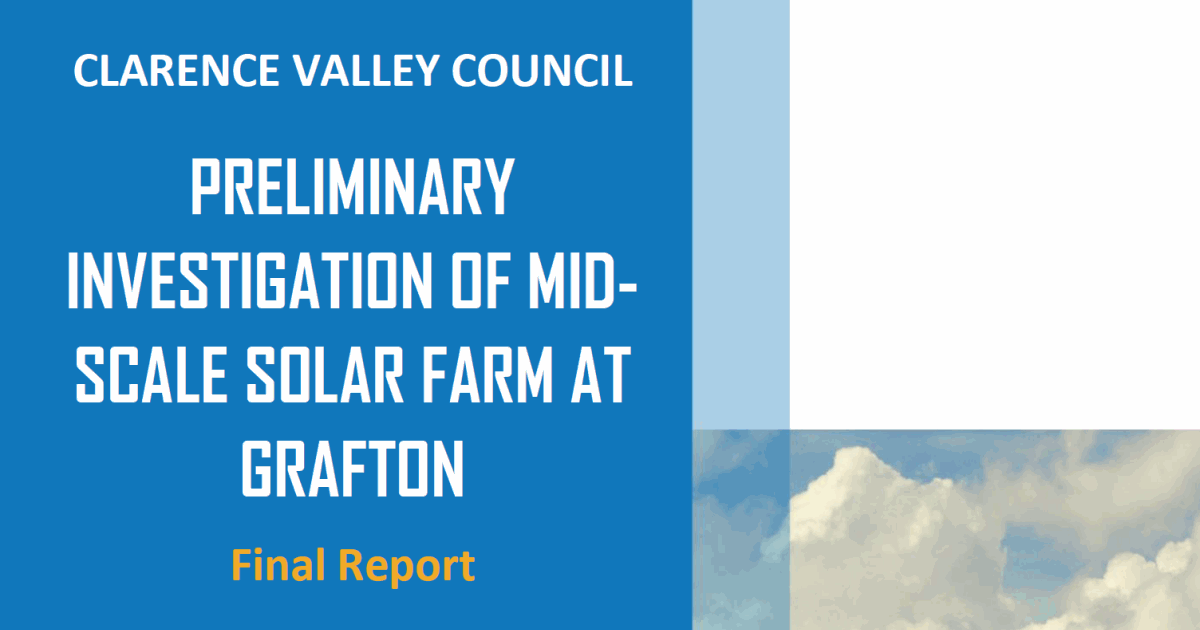
A preliminary investigation has been undertaken for New South Wales’ Clarence Valley Council for a solar farm at the Grafton Regional Landfill & Resource Recovery Facility.
Back in 2018, Council adopted a strategy for meeting targets of reducing its greenhouse gas emissions by 40% before 2030, and for 50% of its electricity to be sourced from renewable energy by the same year. Solar PV was to play an important role in achieving both.
Council now has a portfolio of 42 solar power systems installed on buildings with a generating capacity of more than 1200kW, along with 5 battery systems with a storage capacity of 82kWh.
But there’s still quite a way to go. Clarence Valley Council’s mains grid electricity demand for FY19-20 was estimated at 11.47 GWh and the emissions associated with this electricity was estimated as 10,323 tonnes CO2e (carbon-dioxide equivalent).
One of the other adopted actions in the strategy was to investigate the development of a “mid scale” solar farm on Council land – and the chosen proposed site is an unused portion of the regional landfill facility at Armidale Rd, Elland, south of Grafton.
To be tabled at the Ordinary Council Meeting held tonight, a report from 100% Renewables on the potential project notes the site is in close proximity to 66kV and 11kV distribution lines, the land is north-east facing and experiences high monthly mean daily global solar irradiation. Preliminary enquiries with Essential Energy indicate the clean power station could be connected into the 11kV distribution feeder, subject to network augmentation.
Site Could Host 4.2MW Solar Farm
Several potential configurations for the solar farm of various capacities have been included in the report, ranging from a 1.5MW single-axis tracking system to a 4.2MW East-West fixed-tilt system.
A 4.2 MW solar farm would be capable of generating 6,024 MWh of clean electricity annually, equivalent to 52.93% of Council’s electricity demand. The facility would slash carbon-dioxide equivalent emissions by 5,422 tonnes per annum – or 38% of Council’s current overall emissions footprint. Such a project may involve 5B’s Maverick system, which is a modular, pre-fabricated solar panel and racking solution.
The preliminary investigation notes given the current cost of battery storage, it may not be viable to include it at this point unless external funding is secured. But energy storage will be included in a proposed detailed feasibility study – should that go ahead – to further test the business case. Provision has been made in the draft 2021/22 operational plan to undertake such a study.
It’s anticipated the solar farm will have a 10-year payback, with an operational life of between 25 and 30 years.
If Clarence Valley Council proceeds with this project, it could be the largest PV installation in the local government area, and by quite a margin. The Australian Photovoltaic Institute (APVI) indicates there are only two operational systems above 100kW capacity in the region currently – one 147kW and the other 311kW.
Other established solar farms at landfill facilities in Australia include a 1.1MW project at Albury Waste Management Centre in New South Wales and a 5MW solar farm at Summerhill Waste Management Centre near Newcastle.
Solar Energy In Grafton
In addition to Council’s efforts, solar panels in Grafton are a common sight on homes and businesses as residents increasingly take advantage of the electricity bill-busting benefits of rooftop solar power.
In Grafton’s postcode area (2460), more than 5,152 small-scale (<100kW) systems had been installed to the end of April this year. APVI notes approximately 37.2% of dwellings in the LGA have installations, against a NSW average of around 25%.
SQ’s solar calculator with its default settings indicates a 6.6kW system installed in Grafton has a simple payback of just 3 years, 4 months; and savings over ten years are an estimated $20,877.

 RSS - Posts
RSS - Posts



Sorry threadjacking here. Is there any word on the proposed sun tax? (https://www.solarquotes.com.au/blog/aemc-sun-tax-facts-mb2005/ etc)
The linked article suggests it’ll only be a case of knocking a couple of cents off the FiT – which is annoying but not a major problem, however articles elsewhere suggest having to pay for the privilege of supplying power. Given we’re currently exporting 40+kWh some days that would make solar a terrible investment on my part.
I’d really hate to have to switch off our new solar system simply because it is cheaper to rely on grid power than to run the solar and pay for the ‘privilege’ to export.
Apologies for the threadjacking but it’s something I only recently stumbled over and it has me a little concerned, as does the notion that folk might be charged for having the ability to connect to the grid even if they’ve chosen to disconnect and fully rely on solar and battery.